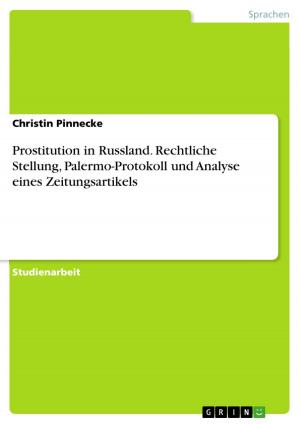Critically compare and contrast the public notification/disclosure programmes currently in operation in the UK and the USA.
Nonfiction, Reference & Language, Law, Criminal Procedure| Author: | Toryill Deacon | ISBN: | 9783656248248 |
| Publisher: | GRIN Verlag | Publication: | July 30, 2012 |
| Imprint: | GRIN Verlag | Language: | English |
| Author: | Toryill Deacon |
| ISBN: | 9783656248248 |
| Publisher: | GRIN Verlag |
| Publication: | July 30, 2012 |
| Imprint: | GRIN Verlag |
| Language: | English |
Essay from the year 2012 in the subject Law - Criminal process, Criminology, Law Enforcement, grade: First, University of Portsmouth (Institute of criminal justice), course: criminology and criminal justice, language: English, abstract: Sex offender policy is one of the most controversial areas of criminal justice policy. The popular hatred of sex offenders as a group is unparalled to any other kind of offender (Jung & Nutely, 2008, p. 191). Over the past few decades, in both the USA and the UK, there has been an unprecedented rise in public and media concern about sex offenders and in particular the risks posed by sex offenders on their release from custody (Kemshall & Maguire, 2003, p. 102). Managing those who are perceived as a danger to society has resulted in the introduction of legislation designed to regulate the behaviour of sex offenders. One of the most notable and widespread statutory reforms was the creation of sex offender registration and community notification laws (McAlinden, 2006, p. 193). Thomas (2005, p. 154) explains that sex offender registration and community notification/disclosure laws require certain categories of sex offenders to notify their names and address, and any changes to these details to the police in the community where they wish to live, this provides the police with a list of previously convicted sex offenders and their crimes. This information is then presumed to be useful when a new crime is reported in that it could help identify suspects. Furthermore, it could be useful in preventing crime and might act as a deterrent (Thomas, 2005, p. 154). The conditions attached to notification and degree of public disclosure permitted to the local community varies depending on the assessed level of risk but public notification/disclosure programmes are useful in that they make it possible for potential victims, their families, and community institutions to protect themselves against known sexual threats (Thomas, 2005, p. 154).
Essay from the year 2012 in the subject Law - Criminal process, Criminology, Law Enforcement, grade: First, University of Portsmouth (Institute of criminal justice), course: criminology and criminal justice, language: English, abstract: Sex offender policy is one of the most controversial areas of criminal justice policy. The popular hatred of sex offenders as a group is unparalled to any other kind of offender (Jung & Nutely, 2008, p. 191). Over the past few decades, in both the USA and the UK, there has been an unprecedented rise in public and media concern about sex offenders and in particular the risks posed by sex offenders on their release from custody (Kemshall & Maguire, 2003, p. 102). Managing those who are perceived as a danger to society has resulted in the introduction of legislation designed to regulate the behaviour of sex offenders. One of the most notable and widespread statutory reforms was the creation of sex offender registration and community notification laws (McAlinden, 2006, p. 193). Thomas (2005, p. 154) explains that sex offender registration and community notification/disclosure laws require certain categories of sex offenders to notify their names and address, and any changes to these details to the police in the community where they wish to live, this provides the police with a list of previously convicted sex offenders and their crimes. This information is then presumed to be useful when a new crime is reported in that it could help identify suspects. Furthermore, it could be useful in preventing crime and might act as a deterrent (Thomas, 2005, p. 154). The conditions attached to notification and degree of public disclosure permitted to the local community varies depending on the assessed level of risk but public notification/disclosure programmes are useful in that they make it possible for potential victims, their families, and community institutions to protect themselves against known sexual threats (Thomas, 2005, p. 154).















